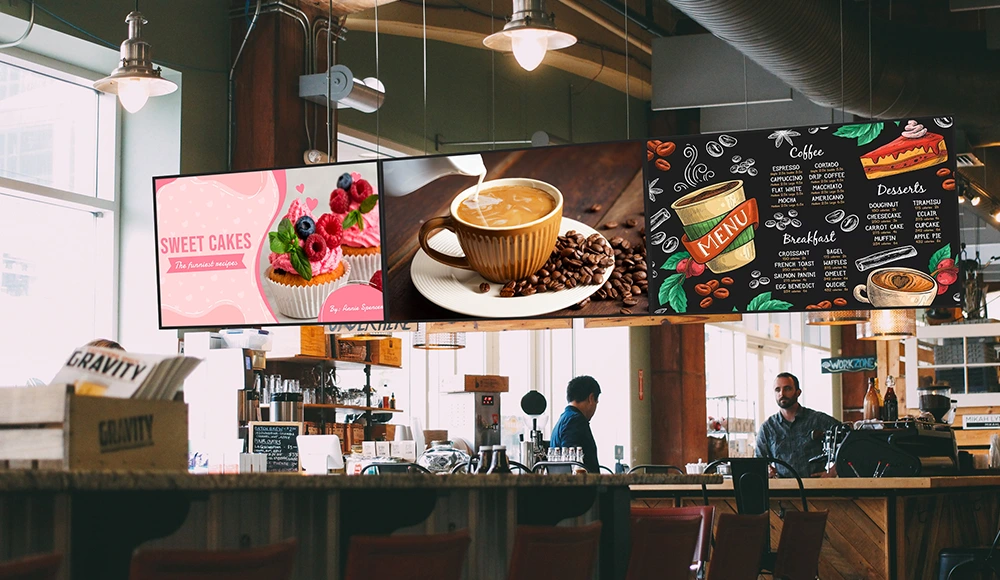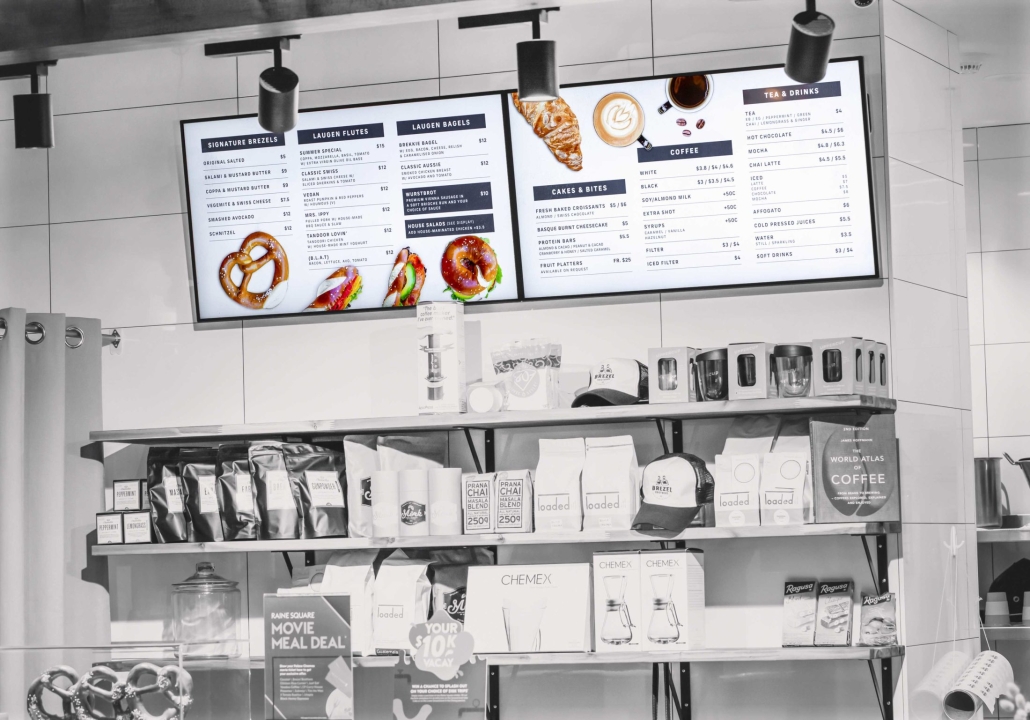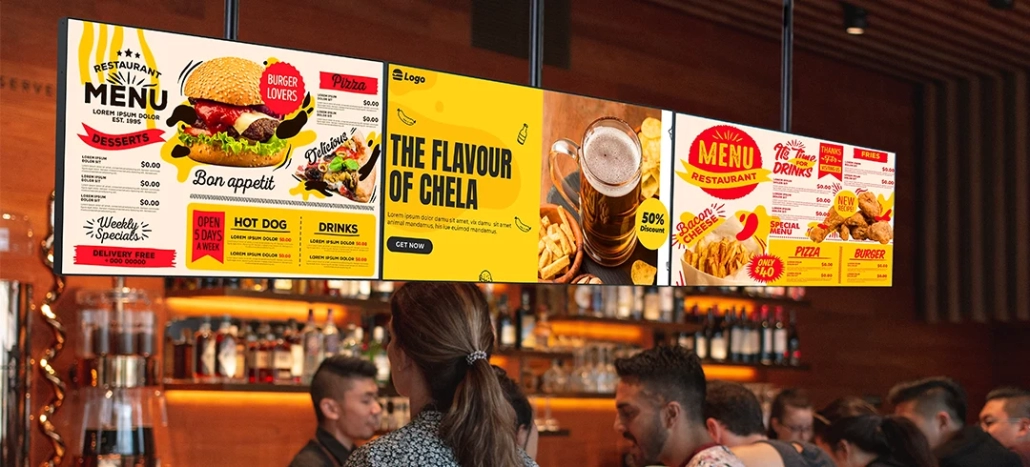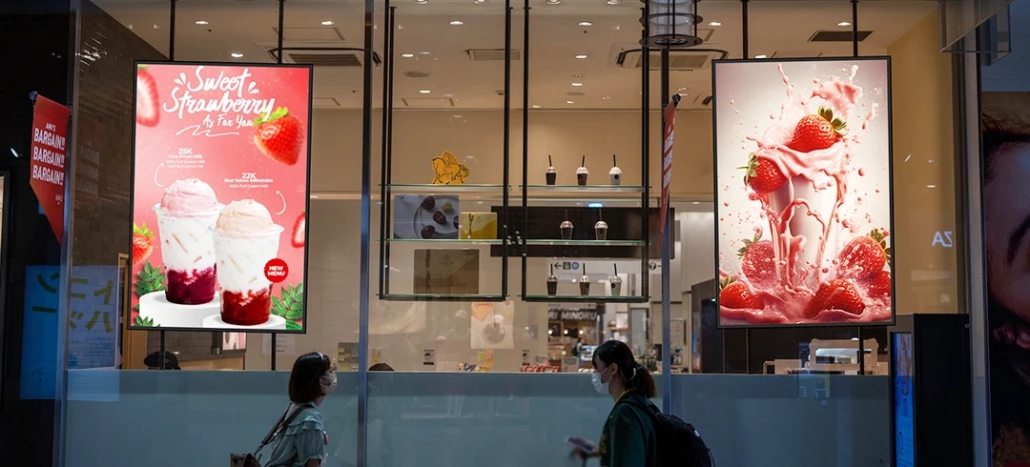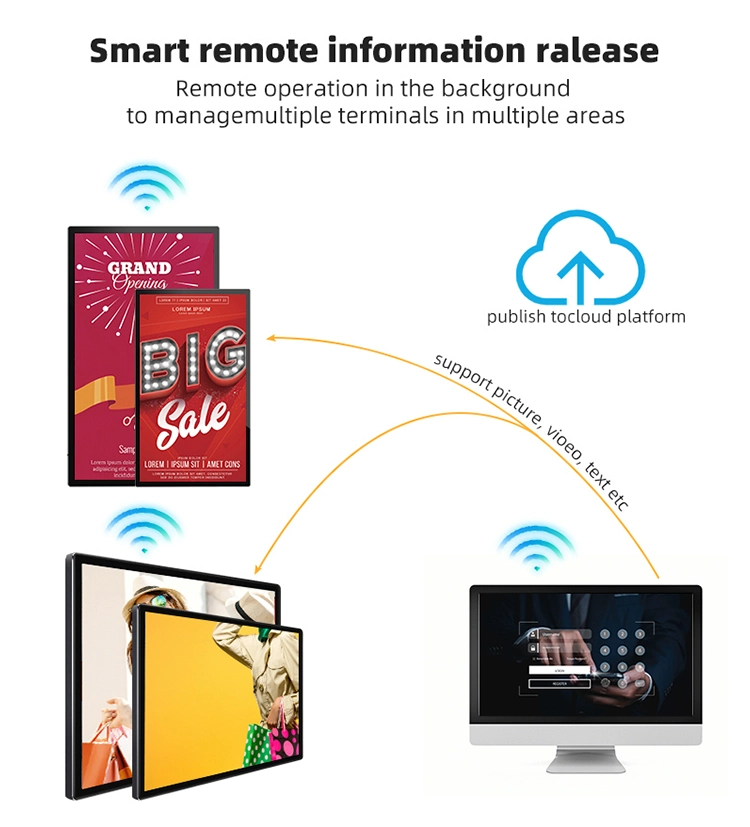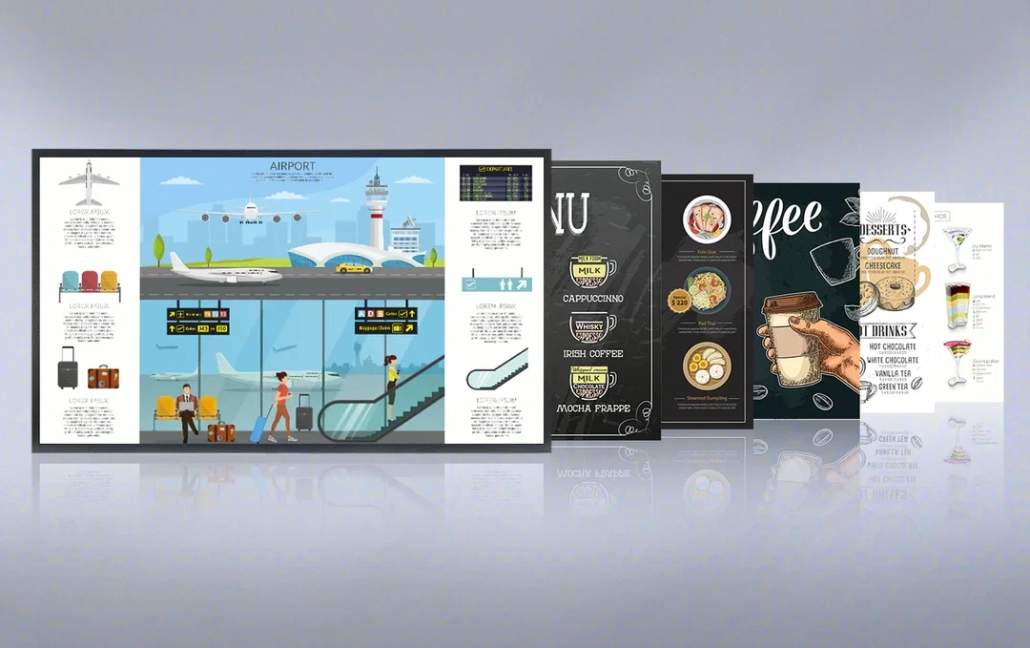The value of digital signage to the catering industry
Regarding the media function needs of the bricks and mortar store industry, digital signage has certain innovative significance. It integrates four functions: necessary content, media information, advertising needs, and external advertising services. Digital signage was first seen in public service areas such as stations and subways. The common presentation is a display screen showing train numbers and other information. Digital signage is also common in the hotel industry, mainly providing information services to guests. It should be noted that the digital signage we usually refer to does not only refer to the hardware aspect. A complete digital signage also includes an online service management system. The hardware is mainly used for display, and the software system is responsible for the regular management and digital control management of screen display content.
If we only evaluate the dimension of advertising, digital signage seems to have little relevance to the catering industry. However, in the eyes of marketers, menus have become a major breakthrough for digital signage to enter the catering industry.
In first-tier cities, digital signage is already very common in the catering industry. After years of development, the significance of digital signage to the catering industry has also jumped out of the category of menus.
Digital signage has become a new solution for the catering industry’s digital media needs
Marketing and advertising, which has been a major pain point in the catering industry earlier.
The contradiction is that the bricks and mortar store industry is different from the Internet industry. The price of external advertising for catering stores is not low, and the consumption scenarios are almost impossible to connect. For example, if a customer sees an advertisement of a certain brand on the subway, it is almost impossible to go to the store immediately, unless the store’s location coincides with the customer’s destination, and the customer must have a good impression of the brand, including the customer’s consumption needs. There must be a certain degree of matching with the consumption scenario.
Later, catering marketers learned wisely. Whether it is marketing or advertising, it must ultimately fall into the revenue aspect. With the current demand for precision marketing, if there is no direct revenue empowerment, it is a pure expenditure that is not worth the investment. In terms of marketing and advertising behavior, most catering people believe that instead of advertising in an external environment with uncertain and unknown personnel, it is better to put advertising content in the elevators of surrounding office buildings, or place an own digital signage at the entrance of the store to achieve more timely effects. (and it’s cheaper).
As for whether digital signage can enhance brand image, let’s not talk about this kind of official discourse. For stores, it is just empty talk if it cannot have a direct effect on conversion.
Through long-term practical application in the catering industry, digital signage can directly sense the increase in orders and focus on profits in the three major areas of welcoming customers, ordering food, and adding food. Highlights the value of catering digital signage.
Compared with manual greeters at the door, the introduction of the brand in terms of digital signage content presentation is easier for passers-by to accept. When customers pass by the restaurant door, if there is a greeter standing, most customers will generally go directly unless they particularly like the brand, means refusing direct sales. In terms of digital signage content without welcome guests, perhaps a video information display of a dish can drive customers to pay attention and enter the store. This is the first value of digital signage in manually guiding customers at the welcome area, but this aspect tests the filtering and interaction capabilities of store information display. Judging from the actual results, focusing on mobile customers at the door has a higher and more direct conversion rate. This is the first step in precision marketing.
The second value of digital signage and precision marketing is reflected in ordering food. When customers pick up the menu and look at the pictures and text in the store, they are still unable to make a choice. At this time, digital signage provides more interactive content, such as more direct and In-depth pictures or videos of dishes can allow customers to directly select products guided by the store, focusing customer needs on signature products or profitable products, and also improving the efficiency and value of customers’ orders.
The third value is reflected in extra meals. There are two types of customers ordering at the store: one is the generous type, where some people always order more, and the other is the conservative type, who basically orders until they are done. How to turn reserved customers into generous customers has always been a core of store growth. There are two directions to choose from: one is to let customers order one more dish to increase per capita consumption, the other is to let customers take packages and give them Bring an extra snack for your family or friends, or even bring a snack for yourself, etc. When customers are dining, specific product introductions on digital signs can do this function well. But there are requirements on this aspect, and it is generally based on the customer’s happy consumption.
With the menu as a breakthrough, digital signage opens up the store’s ability to accelerate iteration
Non-contact welcome conversion, efficiency improvement guidance in ordering, and awakening customers’ demand for extra meals through value output are the three major functions visible to digital signage and directly related to growth. Digital signage actually has greater guiding significance for store development. The visible effects on profits and growth can be classified at the operational level, while those that guide store development can be classified at the strategic empowerment level.
Let’s start with the optimization and change of the menu. Why talk about the menu? The reason is that the menu is a minimal model of a restaurant. Even an outsider can basically understand all kinds of information about a restaurant as long as he can understand the menu of the restaurant. The menu also determines the profitability and future possibilities of a restaurant. In addition, based on the openness of the menu, the iteration and optimization rate of the menu also affects the operation and profitability of a restaurant. However, there are also certain operational difficulties. For example, practitioners cannot change menus frequently. The first is the adaptability of the customer group, the second is the problem of business operations, and the third is the problem of menu implementation. Since we are talking about digital signage, we will only talk about the third category here. Menus are not static. Most high-quality catering brands update their menus very frequently. The minimum is annual updates. Some new fast food brands prefer seasonal updates. Whether they are updated annually, quarterly or monthly, their purpose and direction are generally the same. Two: one is the ups and downs of seasonal recipes, and the other is the optimization of the original menu structure. Even if they want to launch new seasonal products, stores can’t just put a note on them, but some stores do this to save menu update costs and improve operability and flexibility. When there is a physical menu, the store must think carefully about every move of the menu. After the SaaS system optimizes the online function of the menu, the replacement and optimization of the menu have the immediacy of the Internet. However, the contradiction is that most of the hardware used in SaaS will show on the customer’s mobile phone. When ordering, the screen of the customer’s mobile phone is still relatively small.
With digital signage, the value of menu optimization is increased in terms of functionality and flexibility. At this time, the store can optimize the menu at any time. For new products or existing menus, digital signage is more beautiful and more comfortable than mobile phones or tablets. After opening up the function of real-time menu optimization, it will be of certain value to restaurants and catering industries. At this time, stores can also optimize menus on a “daily” or “weekly basis”, and customers will be more interested in a restaurant, a brand, or even the catering industry is no longer the rigid impression it used to be. Under the reconstruction of digital signage, the value of the menu is not to convey information, but to awaken consumption. When we compare the presentation of digital signage with traditional menus, we will find that the menu system of digital signage also has media value. For example, the screen at the welcome desk at the door should be larger, and its focus is on the content presentation of attracting dishes and an overview of restaurant consumption information. At the ordering desk, the restaurant’s must-order dishes, signature dishes, and profitable dishes must be displayed. As the number of diners is determined, the menu system must also recommend appropriate dish combinations and guidance to customers. When dining, to arouse customers’ demand for additional meals, the visual presentation of small portions of dishes, drinks, and soups must be done here.
For a large catering brand, its digital signage also has a certain advertising value, and digital signage can also undertake the landing of catering retail business.
At present, there are all kinds of digital signage manufacturers on the market, and their core is different, but at the same time, there are certain “inferior products” in the market, such as the previous generations of digital signage basic use of U disk storage, which can not really facilitate the store. Some screen brightness is insufficient, in the strong light there will be unclear content. Some digital signage does not even support long standby time. Some also have problems such as background management permissions being too open.
Kontech believes that in the current era of digital signage solutions, the value of service providers should be clear enough, in terms of functions, the first is to solve the color clarity, in order to stimulate customer demand. The second is to achieve unified management of background information to save the time management cost of catering personnel. The third is to do a good job of consumption guidance, in order to improve the per capita customer price and conversion rate. Only when catering brands truly perceive the value of digital signage, practitioners will embark on digital signage construction.
Kontech digital signage combines the Cloud CMS messaging system to form an integrated, comprehensive, customized intelligent cloud “hardware and software” video solution. In Kontech’s view, whether it is menu or video, these can be collectively referred to as advertising, and how to let customers or passers-by see the advertisement immediately trigger consumption. This is a topic that digital signage service providers and caterers should study together. For caterers, cash flow from profits and orders means real empowerment.
For the catering industry, digital signage solves not only the menu function, but also the interactive relationship between media display and customer demand, if the digital signage as a catering industry information media solution, we can see from the outside information, the field of digital signage has not really deep catering service enterprises appear, from the above enterprise service categories can be seen. Some signage companies are still in their infancy. Digital signage companies should enter the catering industry and develop real digital display programs for catering brands. The catering industry, a large market with a market size of trillions and continuing to grow, is indeed worth the attention of digital signage companies.
Nowadays, most signage service providers do not pay enough attention to the catering industry. The core of service providers are still in public areas such as stations and hotel lobbies. There are two contradictions: Firstly, most signage service providers are not familiar with the catering industry. In the past, the catering industry only regarded it as a new tool, and the two parties did not have real close contact. Secondly, the service logic of catering digital signage services is different from that of public areas such as stations. What is tested here is the logical sorting ability of digital signage service providers from public domain to private domain services. In general, digital signage service providers have not truly realized the market value of the catering industry, and the catering industry cannot understand the true empowerment value of digital signage. The two parties’ understanding of the role of digital signage in catering still remains in advertising and menus. This is not only the biggest waste of functions for digital signage companies, but also a market development problem for the catering industry. The contradictory relationship and value still need to be solved in depth by digital signage service providers and catering companies. Exploring the development trends of the digital signage industry, we have also seen the continuous reform of digital signage solutions by technology. First, the deepening of AI. With the reconstruction of intelligent interaction, the importance of digital signage in the catering industry will become increasingly apparent. The second is the optimization of material technology. Flexible screens will also become a highlight of digital signage, making them thinner, lighter and more flexible. In short, digital signage and the catering industry are both developing industries. If the two parties have a deeper collision, this will also change the current presentation and logic of the industry. At least it seems that digital signage can indeed push the operations of the catering industry to a higher dimension.

